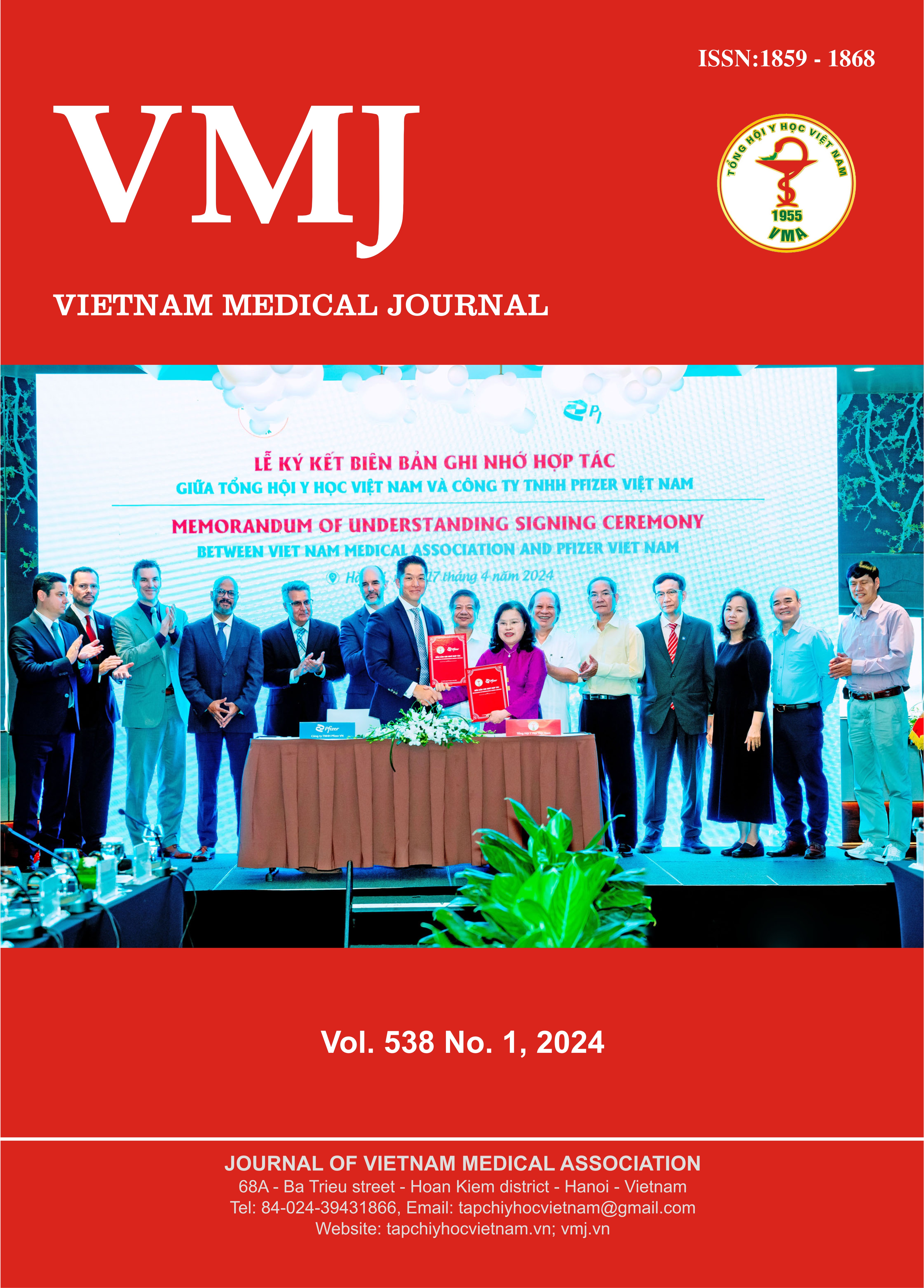APPLICATION OF THE INTERNATIONAL NEUROBLASTOMA RISK GROUP STAGING SYSTEM 2009 (INRGSS 2009) IN DIAGNOSIS AND PROGNOSIS OF CHILDHOOD NEUROBLASTOMA
Main Article Content
Abstract
Background: Neuroblastoma is the most common extracranial solid tumor of childhood. INRGSS 2009 divides patients into stages L1, L2, M, Ms, from which, in combination with histopathology, molecular biology, each patient will be divided into risk groups from which to guide prognosis and suitable treatment. Objectives: Describe the clinical and laboratory features of neuroblastoma in children; distribution of pediatric neuroblastoma stages according to the INRGSS 2009 classification and its value in predicting survival outcomes. Methods: This was a cross-sectional study combined with retrospective and prospective. Patients were diagnosed with neuroblastoma and classified according to INRGSS 2009 at the Pediatric Center, Hue Central Hospital. Results: The age at the time of diagnosis ranged from 1 day old to 9 years old, with a mean of 35.4 ± 25.5 months. Regarding primary tumor, 73.5% of cases were found in the abdomen, the mediastinum region (22.4%), an undetermined region (4.1%). Systemic symptoms, local symptoms and symptoms caused by metastasis were frequently reported. At the time of diagnosis, 73.5% of the patients had distant metastases (stage M or MS). The EFS of the whole group at 12 and 24 months old were 86.3 % and 64.7% respectively. The OS was 77.9% at 24 months old. Most of these patients had a progressive disease: 6.1% were in stage L1; 20.4% were in stage L2; 69.4% were in stage M; and 4.1% were in stage MS. Estimated mean of event-free survival for L1 was 38.7 ± 3.5 months, L2 was 40.5 ± 4.2 months and M was 28.0 ± 2.5 months (p < 0.05). Conclusions: Most neuroblastoma tumors are abdominal and have distant metastases. LDH and ferritin elevations are prevalent. Neuroblastoma outcomes can be predicted using the INRGSS 2009 classification.
Article Details
Keywords
neuroblastoma, children, clinical features, INRGSS 2009
References
2. Philip A Pizzo, David G Poplack (2015), Principles and practice of pediatric oncology, Lippincott Williams & Wilkins,
3. Elizabeth Sokol, Ami V. Desai (2019), "The Evolution of Risk Classification for Neuroblastoma". Children, 6 (2), 27.
4. P. F. Ambros, I. M. Ambros, G. M. Brodeur, M. Haber, J. Khan, A. Nakagawara, G. Schleiermacher, F. Speleman, R. Spitz, W. B. London, S. L. Cohn, A. D. Pearson, J. M. Maris (2009), "International consensus for neuroblastoma molecular diagnostics: report from the International Neuroblastoma Risk Group (INRG) Biology Committee". Br J Cancer, 100 (9), 1471-82.
5. M. L. Bernstein, J. M. Leclerc, G. Bunin, L. Brisson, L. Robison, J. Shuster, T. Byrne, D. Gregory, G. Hill, G. Dougherty, et al. (1992), "A population-based study of neuroblastoma incidence, survival, and mortality in North America". J Clin Oncol, 10 (2), 323-9.
6. G. M. Brodeur, J. Pritchard, F. Berthold, N. L. Carlsen, V. Castel, R. P. Castelberry, B. De Bernardi, A. E. Evans, M. Favrot, F. Hedborg, et al. (1993), "Revisions of the international criteria for neuroblastoma diagnosis, staging, and response to treatment". J Clin Oncol, 11 (8), 1466-77.
7. M. S. Irwin, A. Naranjo, F. F. Zhang, S. L. Cohn, W. B. London, J. M. Gastier-Foster, N. C. Ramirez, R. Pfau, S. Reshmi, E. Wagner, J. Nuchtern, S. Asgharzadeh, H. Shimada, J. M. Maris, R. Bagatell, J. R. Park, M. D. Hogarty (2021), "Revised Neuroblastoma Risk Classification System: A Report From the Children's Oncology Group". J Clin Oncol, 39 (29), 3229-3241.
8. T. Monclair, G. M. Brodeur, P. F. Ambros, H. J. Brisse, G. Cecchetto, K. Holmes, M. Kaneko, W. B. London, K. K. Matthay, J. G. Nuchtern, D. von Schweinitz, T. Simon, S. L. Cohn, A. D. Pearson (2009), "The International Neuroblastoma Risk Group (INRG) staging system: an INRG Task Force report". J Clin Oncol, 27 (2), 298-303.
9. V. Moroz, D. Machin, B. Hero, R. Ladenstein, F. Berthold, P. Kao, Y. Obeng, A. D. J. Pearson, S. L. Cohn, W. B. London (2020), "The prognostic strength of serum LDH and serum ferritin in children with neuroblastoma: A report from the International Neuroblastoma Risk Group (INRG) project". Pediatr Blood Cancer, 67 (8), e28359.
10. A. Naranjo, M. S. Irwin, M. D. Hogarty, S. L. Cohn, J. R. Park, W. B. London (2018), "Statistical Framework in Support of a Revised Children's Oncology Group Neuroblastoma Risk Classification System". JCO Clin Cancer Inform, 2, 1-15.
11. A. A. Ozguven, S. Anak, A. Unuvar, A. Akcay, Z. Karakas, G. Ozturk, O. Devecioglu, L. Agaoğlu (2015), "Outcome in neuroblastoma". Indian J Pediatr, 82 (5), 450-7.
12. E. Sokol, A. V. Desai (2019), "The Evolution of Risk Classification for Neuroblastoma". Children (Basel), 6 (2)
13. J. N. Lucena, M. T. S. Alves, S. C. V. Abib, G. O. Souza, R. P. C. Neves, E. M. M. Caran (2018), "Clinical and epidemiological characteristics and survival outcomes of children with neuroblastoma: 21 years of experience at the instituto de Oncologia Pediátrica, In São Paulo, Brazil". Rev Paul Pediatr, Aspectos clÍnicos, epidemiolÓgicos e sobrevida de crianÇas com neuroblastoma: 21 anos de experiÊncia do instituto de oncologia pediÁtrica, sÃo paulo., 36 (3), 254-260.


